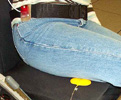Investigators: Eric E. Sabelman, PhD and Jonathan Katz, MD Project Staff: Ruth Yap, MS; Alan K. Nakahara, MS; David L. Jaffe, MS; Betty S. Troy, MS; Beatrice B. Lee, MS; James H. Anderson, JEM; Alyssa Colodny, RN; Susan Ward, RN; and Leonard Goldschmidt, MD, PhD Project Categories: Spinal Cord Injury / Stroke - 2000 Objectives: We propose to test the hypothesis that a wearable motion analysis and pressure feedback system will help prevent skin breakdown in elderly individuals who need to monitor soft tissue pressure. Past Merit Review projects (E601) have led to the creation of a computerized wearable motion analysis system ("WAMAS") with wide potential as a diagnostic and therapeutic device in elder care. The integration of motion and pressure sensing will allow for the monitoring of patient compliance with therapeutic pressure-relief regimens. This integrated system will also be able to interact with other measurement devices, provide real-time sensory feedback to the user, communicate patient status to a remote clinician, and recognize if it is unused or incorrectly used when the patient is not complying with instructions. Background: Individuals with sensorimotor deficits such as spinal cord injury (SCI), stroke (CVA), diabetic neuropathy, prolonged post-surgical immobilization and extreme frailty are at risk for the deleterious effects of skin breakdown. By frequent pressure relief or making sure that certain pressure limits are not exceeded, the patient has a greater potential for keeping skin intact and preventing hospitalization. However, not all patients are compliant with such protocols. The WAMAS system will allow individuals to self-monitor pressure changes, give feedback when pressure limits have been exceeded, allow health care workers to remotely monitor compliance, and/or automatically adjust the environment to bring pressure within desirable limits. Research Plan: We plan to: (Year 1) Replicate 12 additional sets of the 2nd-generation WAMAS. The WAMAS has a hands-free operator unit which exchanges commands and status information with the subject-worn unit over a radio-frequency (RF) serial data link; other RF-communicating devices can be added to establish a local network centered around the WAMAS wearer. Attention will be paid to alternative methods of sensor and computer mounting on the body and environment, to accommodate users with special needs. Input and output modules will be fabricated for skin interface pressure input, tactile and speech outputs, video clip outputs, and remote clinic contact. (Year 1 & 2) Software for extracting trunk or limb angle, time to completion of ADL tasks, pressure profiles, etc., from data will be rewritten and installed. Programs using the new system's capabilities will be tested in the laboratory by a convenience sample of users in each of 3 disability categories. (Year 2 & 3) 12 patients in each of the following categories will be recruited: (a) SCI patients, (b) frail elderly nursing facility residents, and (c) peripheral neuropathy patients for in-clinic testing, with intermittent monitoring by investigators. Pressure relief motion data will be collected using the WAMAS system equipped with triaxial silicon accelerometers applied to the area of interest in conjunction with pressure sensors embedded in clothing or cushions. The prospective study design will compare self-, WAMAS- and observer- reported incidents of overpressure while randomly selected subjects are (a) given a WAMAS system set to record motion and pressure without providing feedback, or (b) given a WAMAS programmed to provide risk-reduction feedback customized for each individual. The following parameters will be recorded for each subject: Hospital admissions for skin breakdown, FIM scores, Braden score for pressure sore risk, Semmes-Weinstein sensory testing of at-risk skin regions, examination by clinician for areas of stage I decubiti or lower extremity wounds that fail to heal in 3 weeks time, compliance with therapeutic pressure relief (by WAMAS-recorded data compared to subject-specific reference). Funding Source: VA RR&D Merit Review |
